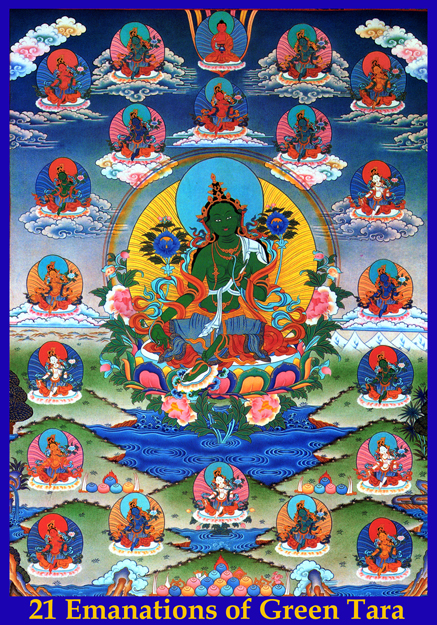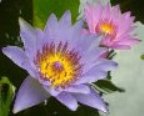Sisters of the Burning
Branch Presents....
Tara
Goddess
of Many Faces
Part
I
Green Tara:
She from Whom All Others Emanate
Protection against Lion (Pride)
Protection against Elephant (Delusion)
Protection against Carnivour
Protection against Earthly Disaster
Protection against Evil Spirits (Doubt)
She of increasing Activities
Protection against Thief (Wrong Views)
Protection against Untimely Death
Protection against Drowning (Avarice)
Protection against War
|
 Dharma
Media
Dharma
Media
|
White Tara
Protection against Famine
Protection against Fire (Anger)
Protection against Drowning (Attachment)
Protection of Indestructibility
Protection Against Politics
Protection Against Sickness
Protection Against Snakes (Envy)
Protection Against Weapons
Protection Against Wind Disasters
She of increasing Power
|
Introduction
There is so much
information on Tara that it is difficult to condense it into a single,
short research paper. Tara is still worshipped today and there are
many, many apparently conflicting sources of information on her. These
exist because she is a living Goddess. There are many groups that each
have their own beliefs and views of her. There are also many Goddesses
throughout history and today that are related to her in some profound
way. Part I of my research on Tara will consist of some basic
background information and a few tales of how she came into being as a
Buddhist Goddess. Part II and III wil give more information on Tara,
the Buddhist Goddess, and Tara, the Hindu diety.
Background
The Goddess Tara has had
many incarations now and far into the past. Her name is linked to many
other Goddesses from around the world. She was the Star Woman of the
Cherokees - Tara means Star in Sanskrit. She became the Earth to feed
her people. She was the Goddess of the Druids. The great hill of the
Druids, Tara, bears her name. Her name is linked to the Tar, a group of
Goddess women of ancient Finland who were wise and powerful. She was
worshipped by ancient Hindus as an aspect of Kali. She is living
Goddess today to the Hindus of the Tantric tradition. She is one of the
10 Mahavidyas or Mothers, manifestations of the Devi. She is the most
beloved diety of the Tibetan Buddhists. She is very similar to Kuan Yin
of the Chinese Buddhist tradition - she is a Goddess of Compassion. She
is also similar to Pavarti of today, with her many different forms,
both friendly & fearsome. Kali is considered to be an aspect of
Parvati. There is a form of the Goddess Tara in every culture. It is
believed that she will assume as many forms on Earth as needed by the
people. In all aspects, she loves and helps the people of the Earth in
every way she can.
Following are several
very beautiful stories concerning the origin of the Buddhist Tara.
Please note that these legends are copied directly from the sources
noted below each section, as they are so beautiful as to require no
changes.
There is a short definitions page included that define some of
the Buddhist terms mentioned in the stories.
This story describes
Tara's royal birth, her spiritual journey, and her choice to remain a
woman to do her work.
Long ago, in an
age before which there was nothing else, the Jina, the Tathagata
Dundubhishvara [some say Amoghasiddhi] came into existence and was
known as the Light of the Various Worlds. The princess Jnanachandra,
'Moon of Wisdom', had the highest reverence for his Teaching, and for
ten million and one hundred thousand years she made offerings to this
Enlightened One, to his shravakas and to the countless host of the
Sangha of Bodhisattvas. . . . Finally, after all this, she awoke to the
initial steps of bodhichitta. At that time some monks said to her, "It
is as a result of these, your roots of virtuous actions, that you have
come into being in this female form. If you pray that your deeds accord
with the Teaching, then surely you will change your form to that of a
man, as is befitting."
After much
discourse, she replied, "In this life there is no such distinction as
'male' and 'female', neither of 'self-identity', 'person' nor any
perception of such, and so attachment to 'male' and 'female' is quite
worthless. . . . Therefore may I, in a female form, work for the
welfare of beings right until Samsara has emptied.". . . Then the
Tathagata Dundubhishvara prophesied, "As long as you can possibly
continue to manifest such supreme bodhi, you will be exclusively known
as Goddess Tara."
The Origin of the
Tara
Tantra TARANATHA
Theosophy
Library Online
This story describes
Tara's birth from the compassionate tears of Avalokiteshvara, who is
currently incarnate as the Dahli Lama.
"Homage! Tara,
swift, heroic! With a glance like flashing lightning, born from a
blooming lotus sprung from the tears on the face of the Lord of the
World!"
... Chapter III,
Tara Tantra
Exotic India
The homage is made
to Tara, who was born from the tears of Avalokiteshvara, the
Bodhisattva of Compassion, embodiment of the mercy of all Buddhas, a
protector of all beings in the realms of desire, form and formlessness
who arise as an 'I' based upon samsaric aggregates.
It is said that
once the Bodhisattva of Compassion became dismayed on seeing that, even
though he had striven with all his might to free the sentient beings
from samsara, the number of the beings suffering in samsara was not
significantly decreasing. He burst into tears and from the pool that
formed from the water issuing from the lotus eyes of the Compassionate
Bodhisattva there sprung forth a lotus. From the lotus appeared Arya
Tara, whose exquisite face embodies the delicacy of a million lotus
blossoms.
Thus the compassion
of all Buddhas emanated as a fountain of enlightened energy, Arya Tara,
divinity of mystical activity who turned to the Bodhisattva of
Compassion and said "O noble one, I offer myself in the service of
freeing countless sentient beings from the cyclic existence as quickly
as possible. Shed no more tears. We shall work together to turn the
battle against samsara".
IloveUlove.com,
Praises in Reference to Legend - Tara the Heroine
This story a historical
rendition of the origins of Tara.
In the seventh
century, Tibet made its entrance onto the international political
stage. King Songtsen Gampo (617-649) unified Tibet and conquered parts
of China and Nepal. He made two important political marriages with
princesses from these neighboring countries. Both ladies practiced
Buddhism, and therefore Buddhism temporarily gained a solid footing in
Tibet. They brought a form of civilization to the then still barbaric
Tibet.
Both princesses
brought Buddha figures with them to Songtsen Gampo’s court. The Chinese
princess Wen-che’ng, a niece of the T’ang emperor, had a gilt figure of
Shakyamuni Buddha with her. This jobo was installed in the Jo-khang
Temple, Lhasa’s most important shrine.
The princesses
practiced Buddhism by doing good deeds. Their ensuing popularity and
the fact that both remained childless - therefore pure, contributed to
their later being identified with the White and Green Taras. Songtsen
Gampo himself was said to be an incarnation of Avalokiteshvara.
Exotic India
Sacred Symbols
|
Her
name:
Symbols:
Animals:
Plants:
Scent:
Gems:
Colors:
|
Star, One who
Saves, The Protectress, Mother Earth, She who brings forth Life
The Star, seven eyes
Owl, Raven, Hare
Lotus (blue & white), any orange flower
Rose
rose quartz, emerald, & any other green or pink stones
Green, white, blue, yellow, & red
|
 |
The Lotus in
different
aspects is a great spiritual symbol all by itself, as well as a symbol
of Tara. She is often pictured in her many aspects both sitting on a
lotus and holding one. The lotus is a beautiful water lily that rises
from the mud to bloom, making it a symbol of both purity &
resurrection. Tara rose from the lake of tears in the same way
Ritual
Tara Mandala:
The 7 all-seeing eyes, The Star, The Tara Brooch Celtic knot
The Crescent Moon, The Blue Lotus, The Full Moon, The Colors of Tara

Original
art by Holly |
Tibetan Homage to
Manifestations Of Tara
I bow to the Body of Tara, who saves from the eight fears.
I bow to the Body of Tara, of infinite fame.
I bow to the Body of Tara, the world's benefactor.
I bow to the Body of Tara, sure curer of sorrow.
I bow to the Body of Tara, of a thousand hands and eyes.
I bow to the Body of Tara, infinite as space.
I bow to the Body of Tara, adorned with the Marks and the
Signs.
I bow to the Body of Tara, whose limbs are like the moon.
I bow to the Body of Tara, who is as bright as the sun.
I bow to the Body of Tara, unchanging in the three times.
I bow to the Body of Tara, supporting like earth.
I bow to the Body of Tara, cohering like water.
I bow to the Body of Tara, ripening like fire.
I bow to the Body of Tara, expanding like air.
I bow to the Body of Tara, who is the Sovereign of Doctors.
I bow to the Body of Tara, subduing disease like medicine.
I bow to the Body of Tara, the river of compassion.
I bow to the Body of Tara, skilled in means like taming.
I bow to the Body of Tara, lovely yet free of desire
I bow to the Body of Tara, who teaches the Way of Freedom.
www.iloveulove.com
|
Sources
"Goddess Days" by
Nancey Blair, pp 132, 292
Fair Winds Press
Gloucester, MA
2002
365 Goddess, March 3
entry
Patricia Telesco
Harper-Collins Publishers
New York, NY
1998
www.iloveulove.com
- The Twenty-one Praises of TARA
Western
Buddhist Review - Tara: Her Origins and Development by Dharmachari
Purna
Lady
of the Flame - Green Tara: Notes for Performing her Puja by Drea
Bradley
goddessgift.com
- Tara, Goddess of Peace and Protection
goddessmystic.com
- Tara, Goddess of Peace and Protection
exoticindiaart.com -
Tara, Goddess of Peace and Protection
theosophy.org
- Tara, Goddess of Peace and Protection
theosophy.org
- Tara, Goddess of Peace and Protection
khandro.net -
Female Deities
goddess.ws - TARA - Tibetan
Goddess of Compassion
irishstore.com -
Traditional Tara Brooch
This
page is the intellectual and
creative
property of Holly.
2005
Return
 Dharma
Media
Dharma
Media


